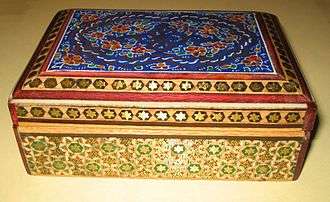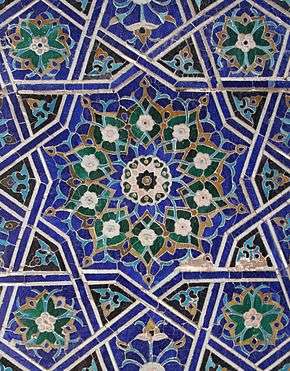Khatam

Khātam (Persian: خاتم) is a Persian version of marquetry, art forms made by decorating the surface of wooden articles with delicate pieces of wood, bone and metal precisely-cut geometrical shapes. Khatam is also the capital of Khatam County in Iran. Khatam kari (Persian: خاتمکاری) is the art of crafting a Khatam. Common materials used in the construction of inlaid articles are gold, silver, brass, aluminum and twisted wire.
Design and construction
Designing of inlaid articles is a highly elaborate process. In each cubic centimeter of inlaid work, up to approximately 250 pieces of metal, bone, ivory and different kinds of wood are laid side by side, glued together in stages, smoothed, oiled and polished. Inlaid articles in the Safavid era took on a special significance as artists created their precious artworks. Woods used include betel, walnut, cypress and pine. These works include doors and windows, mirror frames, Quran boxes, inlaid boxes, pen and penholders, lanterns and shrines.[1][2]
Examples
The ornamentation of the doors of holy places predominantly consists of inlaid motifs. Samples of these can be observed in the cities of Mashhad, Qom, Shiraz and Rey. In the Safavid era, the art of marquetry flourished in the southern cities of Iran, especially in Isfahan, Shiraz and Kerman. The inlaid-ornamented rooms at the Saadabad Palace and the Marble Palace in Tehran are among masterpieces of this art.
Current status
Khatam is practiced in Isfahan, Shiraz and Tehran. The art of inlaid and sudorific woodwork is undertaken in the workshops of the Cultural Heritage Organization of Iran, as well as in private workshops.
References
- ↑ Burke, Andrew (15 September 2010). Iran. Lonely Planet. p. 70. ISBN 978-1-74220-349-2.
- ↑ Shojanoori, Nikoo (2014). "A Background of Khatam Art". European Online Journal of Natural and Social Sciences. 3 (4. Special I ssue on Architecture, Urbanism, and Civil Engineering).
